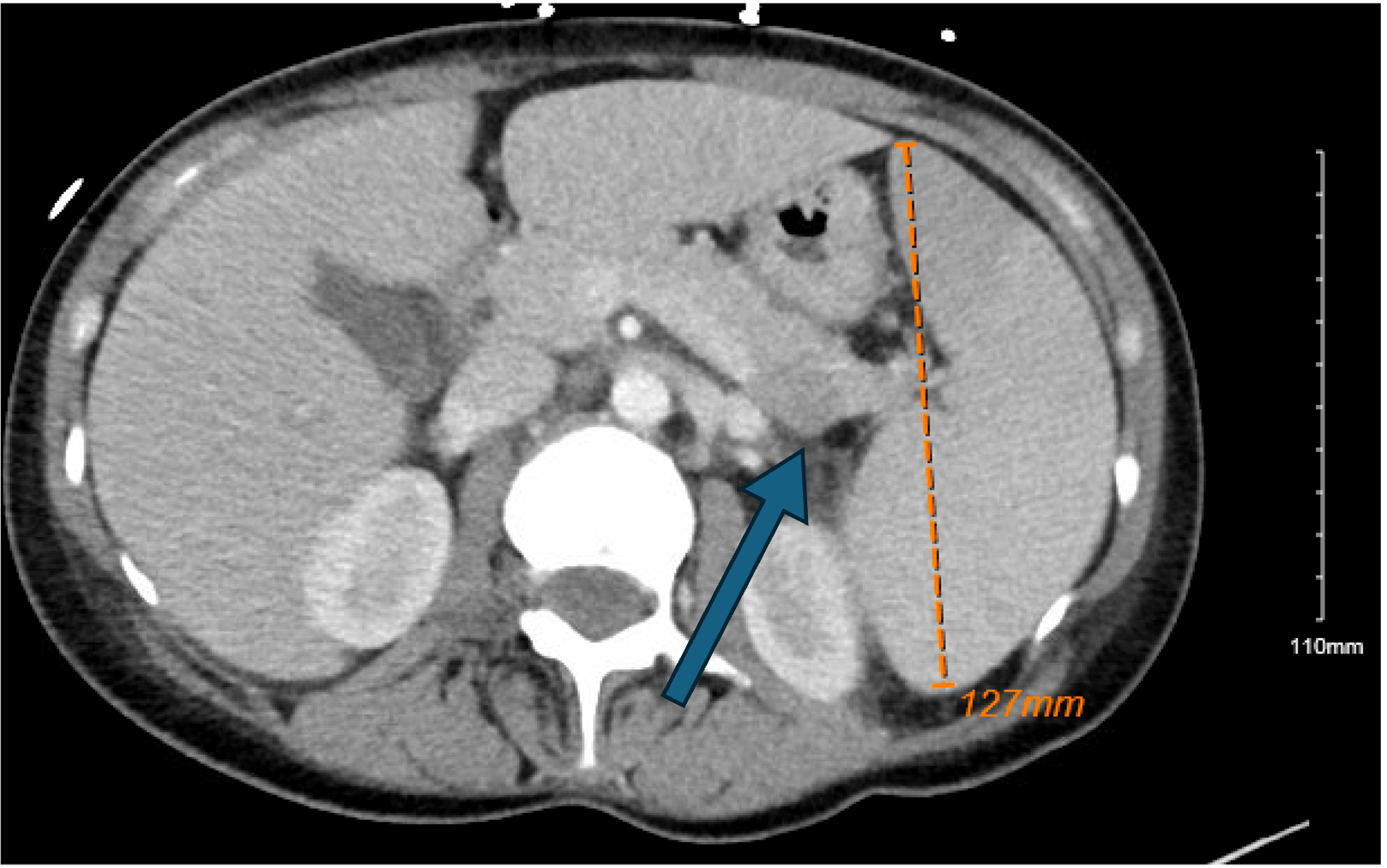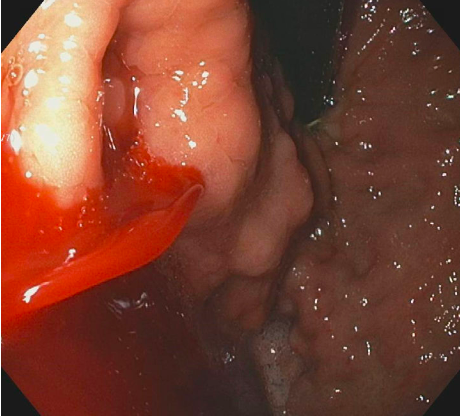Monday Poster Session
Category: Biliary/Pancreas
P2238 - Beyond the Bleed: Unveiling a Pancreatic Neuroendocrine Tumor Through Variceal Hemorrhage
Monday, October 27, 2025
10:30 AM - 4:00 PM PDT
Location: Exhibit Hall

Jalal Samhoun, MD
Florida Atlantic University Charles E. Schmidt College of Medicine
Boca Raton, FL
Presenting Author(s)
Jalal Samhoun, MD1, Kyle Gordon, MD1, Hasan Ilyas, MD1, Allison Chin, MD2, Zoilo K. Suarez, MD1, Roozbeh Nazarian, MD1
1Florida Atlantic University Charles E. Schmidt College of Medicine, Boca Raton, FL; 2Florida Atlantic University Charles E. Schmidt College of Medicine, Miami, FL
Introduction: Pancreatic neuroendocrine tumors (PNETs) are rare neoplasms that seldom present with gastrointestinal hemorrhage. Variceal bleeding from isolated gastric varices is an especially rare manifestation of a PNET. Such bleeding usually results from sinistral (left-sided) portal hypertension due to splenic vein thrombosis, rather than cirrhosis-related portal hypertension. We report a case of a PNET presenting as gastric variceal hemorrhage.
Case Description/
Methods: A 43-year-old noncirrhotic woman presented with syncope and large-volume hematemesis (hemoglobin 5.1 g/dL). Computed tomography (CT) revealed splenomegaly and a 2 cm pancreatic tail mass causing splenic vein thrombosis (Figure 1). Emergent endoscopy confirmed actively bleeding fundal varices (isolated gastric varices, IGV1) (Figure 2) without esophageal varices, and hemostasis was achieved with through-the-scope hemoclips and endoscopic ultrasound (EUS)-guided coil embolization.
EUS-guided fine-needle biopsy of the pancreatic tail lesion confirmed a well-differentiated PNET. The patient underwent robotic distal pancreatectomy with splenectomy. Pathology showed a World Health Organization (WHO) Grade 3 PNET (Ki-67 30%) invading the spleen, with 3 of 9 lymph nodes positive and clear surgical margins; oncology recommended surveillance.
Discussion: Splenic vein thrombosis elevates pressure in the left-sided portal system (splenic and short gastric veins), causing isolated gastric varices. This condition, termed sinistral portal hypertension, is most often secondary to pancreatic disease and is a rare but important cause of variceal bleeding. Pancreatic tail tumors, such as PNETs, can precipitate splenic vein thrombosis, leading to gastric variceal hemorrhage.
Though uncommon, PNET-related left-sided portal hypertension with bleeding has been reported. In this case, endoscopic therapy controlled the acute variceal bleeding, and definitive surgical resection of the PNET with splenectomy eliminated the source of portal hypertension, preventing rebleeding. This case underscores the need to consider sinistral portal hypertension in noncirrhotic variceal bleeding and to evaluate for underlying pancreatic pathology, as early recognition and management of splenic vein thrombosis can be lifesaving.

Figure: Figure 1. Axial contrast-enhanced CT abdomen demonstrating marked splenomegaly measuring approximately 12.7 cm, with evidence of splenic vein thrombus and associated prominent varices at the splenic hilum consistent with left-sided (sinistral) portal hypertension.

Figure: Figure 2. Endoscopic view demonstrating prominent gastric fundal varices. characterized by tortuous, dilated submucosal vessels with active bleeding.
Disclosures:
Jalal Samhoun indicated no relevant financial relationships.
Kyle Gordon indicated no relevant financial relationships.
Hasan Ilyas indicated no relevant financial relationships.
Allison Chin indicated no relevant financial relationships.
Zoilo Suarez indicated no relevant financial relationships.
Roozbeh Nazarian indicated no relevant financial relationships.
Jalal Samhoun, MD1, Kyle Gordon, MD1, Hasan Ilyas, MD1, Allison Chin, MD2, Zoilo K. Suarez, MD1, Roozbeh Nazarian, MD1. P2238 - Beyond the Bleed: Unveiling a Pancreatic Neuroendocrine Tumor Through Variceal Hemorrhage, ACG 2025 Annual Scientific Meeting Abstracts. Phoenix, AZ: American College of Gastroenterology.
1Florida Atlantic University Charles E. Schmidt College of Medicine, Boca Raton, FL; 2Florida Atlantic University Charles E. Schmidt College of Medicine, Miami, FL
Introduction: Pancreatic neuroendocrine tumors (PNETs) are rare neoplasms that seldom present with gastrointestinal hemorrhage. Variceal bleeding from isolated gastric varices is an especially rare manifestation of a PNET. Such bleeding usually results from sinistral (left-sided) portal hypertension due to splenic vein thrombosis, rather than cirrhosis-related portal hypertension. We report a case of a PNET presenting as gastric variceal hemorrhage.
Case Description/
Methods: A 43-year-old noncirrhotic woman presented with syncope and large-volume hematemesis (hemoglobin 5.1 g/dL). Computed tomography (CT) revealed splenomegaly and a 2 cm pancreatic tail mass causing splenic vein thrombosis (Figure 1). Emergent endoscopy confirmed actively bleeding fundal varices (isolated gastric varices, IGV1) (Figure 2) without esophageal varices, and hemostasis was achieved with through-the-scope hemoclips and endoscopic ultrasound (EUS)-guided coil embolization.
EUS-guided fine-needle biopsy of the pancreatic tail lesion confirmed a well-differentiated PNET. The patient underwent robotic distal pancreatectomy with splenectomy. Pathology showed a World Health Organization (WHO) Grade 3 PNET (Ki-67 30%) invading the spleen, with 3 of 9 lymph nodes positive and clear surgical margins; oncology recommended surveillance.
Discussion: Splenic vein thrombosis elevates pressure in the left-sided portal system (splenic and short gastric veins), causing isolated gastric varices. This condition, termed sinistral portal hypertension, is most often secondary to pancreatic disease and is a rare but important cause of variceal bleeding. Pancreatic tail tumors, such as PNETs, can precipitate splenic vein thrombosis, leading to gastric variceal hemorrhage.
Though uncommon, PNET-related left-sided portal hypertension with bleeding has been reported. In this case, endoscopic therapy controlled the acute variceal bleeding, and definitive surgical resection of the PNET with splenectomy eliminated the source of portal hypertension, preventing rebleeding. This case underscores the need to consider sinistral portal hypertension in noncirrhotic variceal bleeding and to evaluate for underlying pancreatic pathology, as early recognition and management of splenic vein thrombosis can be lifesaving.

Figure: Figure 1. Axial contrast-enhanced CT abdomen demonstrating marked splenomegaly measuring approximately 12.7 cm, with evidence of splenic vein thrombus and associated prominent varices at the splenic hilum consistent with left-sided (sinistral) portal hypertension.

Figure: Figure 2. Endoscopic view demonstrating prominent gastric fundal varices. characterized by tortuous, dilated submucosal vessels with active bleeding.
Disclosures:
Jalal Samhoun indicated no relevant financial relationships.
Kyle Gordon indicated no relevant financial relationships.
Hasan Ilyas indicated no relevant financial relationships.
Allison Chin indicated no relevant financial relationships.
Zoilo Suarez indicated no relevant financial relationships.
Roozbeh Nazarian indicated no relevant financial relationships.
Jalal Samhoun, MD1, Kyle Gordon, MD1, Hasan Ilyas, MD1, Allison Chin, MD2, Zoilo K. Suarez, MD1, Roozbeh Nazarian, MD1. P2238 - Beyond the Bleed: Unveiling a Pancreatic Neuroendocrine Tumor Through Variceal Hemorrhage, ACG 2025 Annual Scientific Meeting Abstracts. Phoenix, AZ: American College of Gastroenterology.
